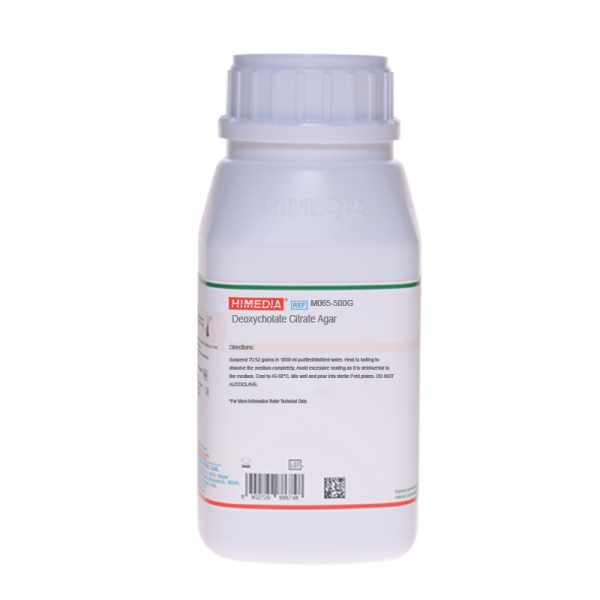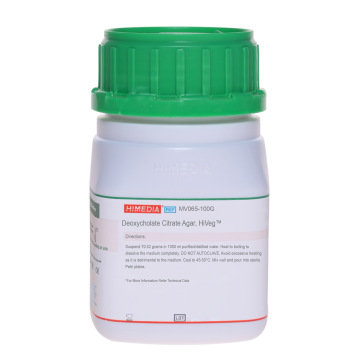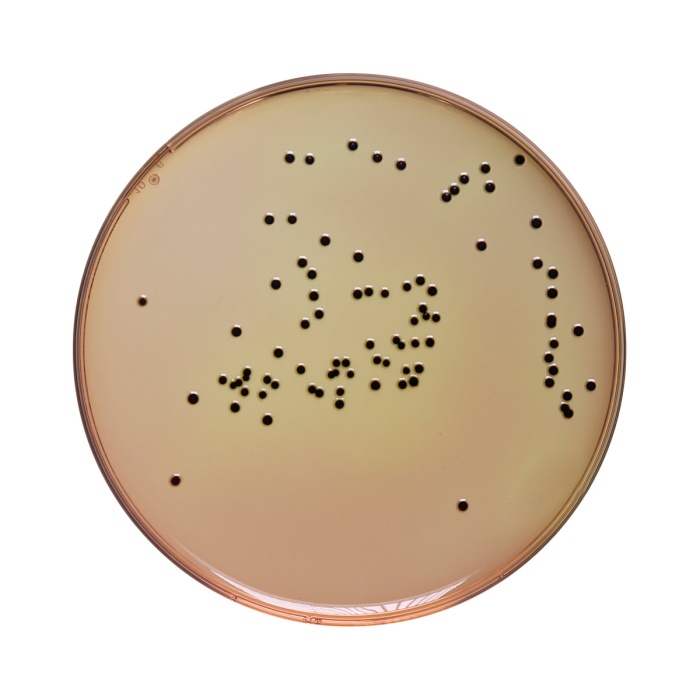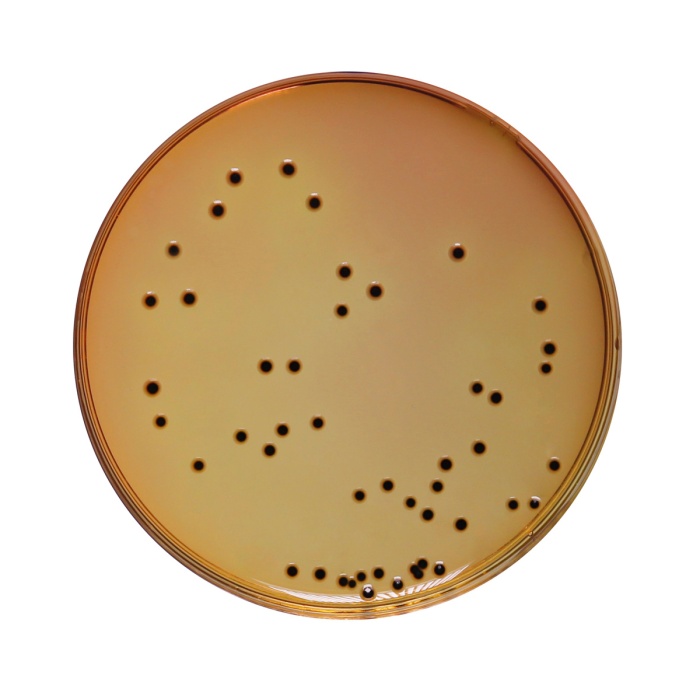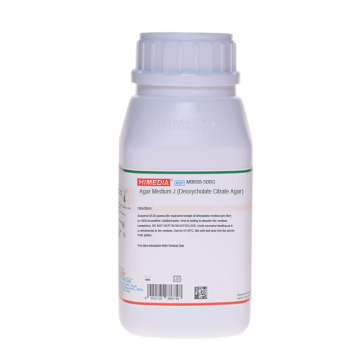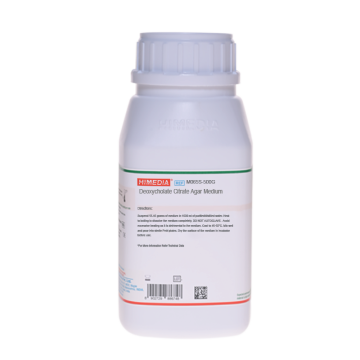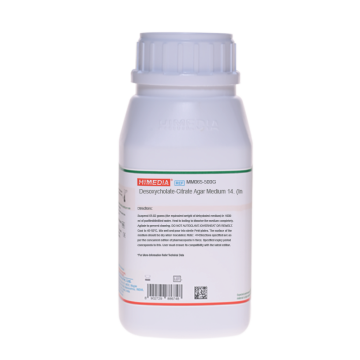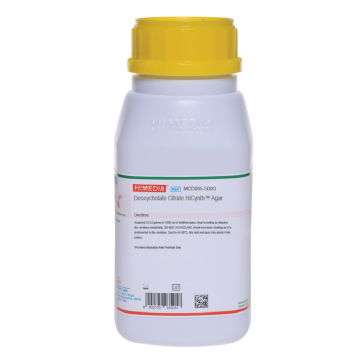 Your enquiry has been submitted
Your enquiry has been submitted
Deoxycholate Citrate Agar
Salmonella Shigella#CC293D
Intended Use:
Recommended for the isolation of enteric pathogens particularly Salmonella and Shigella species from clinical samples.
Composition**
| Ingredients | g/L |
|---|---|
| HI solids # | 10.000 |
| Proteose peptone | 10.000 |
| Lactose | 10.000 |
| Sodium deoxycholate | 5.000 |
| Neutral red | 0.020 |
| Sodium citrate | 20.000 |
| Ferric ammonium citrate | 2.000 |
| Agar | 13.500 |
Final pH (at 25°C) 7.5±0.2
**Formula adjusted, standardized to suit performance parameters
# Equivalent to Heart Infusion solids
Directions
Suspend 70.52 grams in 1000 ml of purified / distilled water. Heat to boiling to dissolve the medium completely. DO NOT AUTOCLAVE. Avoid excessive heating as it is detrimental to the medium. Cool to 45-50°C. Mix well and pour into sterile Petri plates.
Principle And Interpretation
Deoxycholate Citrate Agar is prepared as per the modified formula of Leifson (1). This medium is used for the isolation and maximum recovery of intestinal pathogens belonging to Salmonella and Shigella groups from foods (2). However, it is recommended to use less inhibitory medium when Shigella have to be isolated (3). The selectivity of this medium permits the use of fairly heavy inocula without danger of overgrowth of Shigella and Salmonella by other microflora. For the routine examination of stool and urine specimens, it is suggested that other media such as MacConkey Agar (M082), Bismuth Sulphite Agar (M027) etc. be used in conjunction with this medium.
This medium is similar to deoxycholate agar in comparison but is moderately more selective for enteric pathogens owing to increased concentrations of both citrate and deoxycholate salts. Sodium deoxycholate at pH 7.3 to 7.5 is inhibitory for gram-positive bacteria. Citrate salts, in the concentration included in the formulation, are inhibitory to gram-positive bacteria and most other normal intestinal organisms.
HI solids is a source of carbon and nitrogen and this ingredient is used because the inhibition of coliforms produced is greater than when an extract or simple peptone is used. Proteose peptone provides carbon, nitrogen, vitamins and minerals. Coliform bacteria and gram-positive bacteria are inhibited or greatly suppressed due to sodium deoxycholate, sodium citrate and ferric ammonium citrate. Lactose helps in differentiating enteric bacilli, as lactose fermenters produce red colonies while lactose non-fermenters produce colourless colonies. Coliform bacteria, if present form pink colonies on this medium. The degradation of lactose causes acidification of the medium surrounding the relevant colonies and the pH indicator neutral red changes its colour to red. These colonies usually are also surrounded by a turbid zone of precipitated deoxycholic acid due to acidification of the medium. Sodium deoxycholate combines with neutral red in an acidic environment, causing the dye to go out of the solution with the subsequent precipitation of deoxycholate (1). The reduction of ferric ammonium citrate to iron sulfide is indicated by the formation of black iron sulfide. Salmonella and Shigella species do not ferment lactose but Salmonella may produce H2S, forming colorless colonies with or without black centers. Citrate and iron (Fe) combination has a strong hydrolyzing effect on agar when the medium is heated, producing a soft and unelastic agar. If autoclaved the agar becomes soft and almost impossible to streak. Salmonella Gallinarum is inhibited if sodium deoxycholate concentration is increased to 0.1% or greater (1). Surface colonies of non-lactose fermenters often absorb a little colour (pinkish) from the medium and organisms may be mistaken for coliforms (1).
Type of specimen
Clinical- stool samples, urine samples; Food samples.
Specimen Collection and Handling
For clinical samples follow appropriate techniques for handling specimens as per established guidelines (4,5). For food samples, follow appropriate techniques for sample collection and processing as per guidelines (2). After use, contaminated materials must be sterilized by autoclaving before discarding
Warning and Precautions
In Vitro diagnostic use. For professional use only. Read the label before opening the container. Wear protective gloves/protective clothing/eye protection/face protection. Follow good microbiological lab practices while handling specimens and culture. Standard precautions as per established guidelines should be followed while handling clinical specimens. Safety guidelines may be referred in individual safety data sheets.
Limitations
- 1. Individual organisms differ in their growth requirement and may show variable growth patterns on the medium.
- 2. Each lot of the medium has been tested for the organisms specified on the COA. It is recommended to users to validate the medium for any specific microorganism other than mentioned in the COA based on the user's unique requirement.
- 3. Further biochemical identification is required for confirmation of species.
Performance and Evaluation
Performance of the medium is expected when used as per the direction on the label within the expiry period when stored at recommended temperature.
Quality Control
Appearance Light yellow to pinkish beige homogeneous free flowing powder
Gelling Firm, comparable with 1.35% Agar gel.
Colour and Clarity of prepared medium Reddish orange coloured, clear to slightly opalescent gel forms in Petri plates
Reaction Reaction of 7.05% w/v aqueous solution at 25°C. pH : 7.5±0.2
pH 7.30-7.70
Cultural Response
Cultural characteristics observed after an incubation at 35-37°C for 18-24 hours.
| Organism | Inoculum (CFU) | Growth | Recovery | Colour of Colony | H2S |
|---|---|---|---|---|---|
| Enterococcus faecalis ATCC 29212 (00087*) | >=104 | inhibited | 0% | ||
| Escherichia coli ATCC 25922 (00013*) | 50-100 | poor | 20-30% | pink with bile precipitate | negative reaction |
| Salmonella Enteritidis ATCC 13076 (00030*) | 50-100 | good-luxuriant | >=50% | colourless | positive reaction, black centered colonies |
| Salmonella Typhimurium ATCC 14028 (00031*) | 50-100 | good-luxuriant | >=50% | colourless | positive reaction, black centered colonies |
| Shigella flexneri ATCC 12022 (00126*) | 50-100 | good | 40-50% | colourless | |
| Escherichia coli ATCC 8739 (00012*) | 50-100 | poor | 20-30% | pink with bile precipitate | negative reaction |
| Salmonella Abony NCTC 6017 (00029*) | 50-100 | good-luxuriant | >=50% | colourless | reaction, black centered colonies |
| Staphylococcus aureus subsp. aureus ATCC 25923 (00034*) | >=104 | inhibited | 0% |
Key:
*Corresponding WDCM numbers.
Storage and Shelf Life
Store between 10-30°C in a tightly closed container and the prepared medium at 20-30°C. Use before expiry date on the label. On opening, product should be properly stored dry, after tightly capping the bottle in order to prevent lump formation due to the hygroscopic nature of the product. Improper storage of the product may lead to lump formation. Store in dry ventilated area protected from extremes of temperature and sources of ignition Seal the container tightly after use. Product performance is best if used within stated expiry period.
Disposal
User must ensure safe disposal by autoclaving and/or incineration of used or unusable preparations of this product. Follow established laboratory procedures in disposing of infectious materials and material that comes into contact with clinical sample must be decontaminated and disposed of in accordance with current laboratory techniques (4,5).
Reference
- 1. Leifson, 1935, J. Path. Bact., 40:581.
- 2. Salfinger Y., and Tortorello M.L., 2015, Compendium of Methods for the Microbiological Examination of Foods, 5th Ed., American Public Health Association, Washington, D.C.
- 3. Frieker C.R., 1987, J. Appl. Bact., 63:99.
- 4. Isenberg, H.D. Clinical Microbiology Procedures Handbook 2nd Edition.
- 5. Jorgensen, J.H., Pfaller, M.A., Carroll, K.C., Funke, G., Landry, M.L., Richter, S.S and Warnock., D.W. (2015) Manual of Clinical Microbiology, 11th Edition. Vol. 1.
| Product Name | Deoxycholate Citrate Agar |
|---|---|
| SKU | M065 |
| Product Type | Regular |
| Physical Form | Powder |
| Origin | Animal |
| Packaging type | HDPE |
| References | 1. Leifson, 1935, J. Path. Bact., 40:581. 2.Speck M. (Ed.), 1984, Compendium of Methods for the Microbiological Examination of Foods, 2nd ed., APHA,Washington, D.C. 3.Frieker C.R., 1987, J. Appl. Bact., 63:99. 4.Isenberg, H.D. Clinical Microbiology Procedures Handbook. 2nd Edition. 5.Jorgensen,J.H., Pfaller , M.A., Carroll, K.C., Funke, G., Landry, M.L., Richter, S.S and Warnock., D.W. (2015)Manual of Clinical Microbiology, 11th Edition. Vol. 1. |
| Customized Product Available | No |



